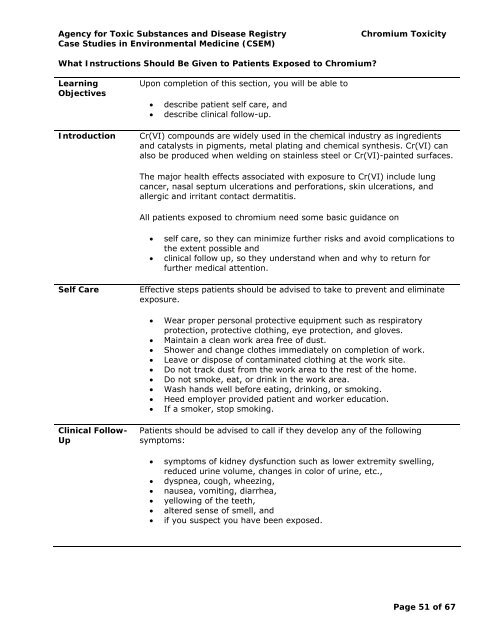(Cr) Toxicity | ATSDR - CSEM - Agency for Toxic Substances and ...
(Cr) Toxicity | ATSDR - CSEM - Agency for Toxic Substances and ...
(Cr) Toxicity | ATSDR - CSEM - Agency for Toxic Substances and ...
You also want an ePaper? Increase the reach of your titles
YUMPU automatically turns print PDFs into web optimized ePapers that Google loves.
<strong>Agency</strong> <strong>for</strong> <strong>Toxic</strong> <strong>Substances</strong> <strong>and</strong> Disease Registry Chromium <strong><strong>Toxic</strong>ity</strong><br />
Case Studies in Environmental Medicine (<strong>CSEM</strong>)<br />
What Instructions Should Be Given to Patients Exposed to Chromium?<br />
Learning<br />
Objectives<br />
Upon completion of this section, you will be able to<br />
• describe patient self care, <strong>and</strong><br />
• describe clinical follow-up.<br />
Introduction <strong>Cr</strong>(VI) compounds are widely used in the chemical industry as ingredients<br />
<strong>and</strong> catalysts in pigments, metal plating <strong>and</strong> chemical synthesis. <strong>Cr</strong>(VI) can<br />
also be produced when welding on stainless steel or <strong>Cr</strong>(VI)-painted surfaces.<br />
The major health effects associated with exposure to <strong>Cr</strong>(VI) include lung<br />
cancer, nasal septum ulcerations <strong>and</strong> per<strong>for</strong>ations, skin ulcerations, <strong>and</strong><br />
allergic <strong>and</strong> irritant contact dermatitis.<br />
All patients exposed to chromium need some basic guidance on<br />
• self care, so they can minimize further risks <strong>and</strong> avoid complications to<br />
the extent possible <strong>and</strong><br />
• clinical follow up, so they underst<strong>and</strong> when <strong>and</strong> why to return <strong>for</strong><br />
further medical attention.<br />
Self Care Effective steps patients should be advised to take to prevent <strong>and</strong> eliminate<br />
exposure.<br />
Clinical Follow-<br />
Up<br />
• Wear proper personal protective equipment such as respiratory<br />
protection, protective clothing, eye protection, <strong>and</strong> gloves.<br />
• Maintain a clean work area free of dust.<br />
• Shower <strong>and</strong> change clothes immediately on completion of work.<br />
• Leave or dispose of contaminated clothing at the work site.<br />
• Do not track dust from the work area to the rest of the home.<br />
• Do not smoke, eat, or drink in the work area.<br />
• Wash h<strong>and</strong>s well be<strong>for</strong>e eating, drinking, or smoking.<br />
• Heed employer provided patient <strong>and</strong> worker education.<br />
• If a smoker, stop smoking.<br />
Patients should be advised to call if they develop any of the following<br />
symptoms:<br />
• symptoms of kidney dysfunction such as lower extremity swelling,<br />
reduced urine volume, changes in color of urine, etc.,<br />
• dyspnea, cough, wheezing,<br />
• nausea, vomiting, diarrhea,<br />
• yellowing of the teeth,<br />
• altered sense of smell, <strong>and</strong><br />
• if you suspect you have been exposed.<br />
Page 51 of 67

















